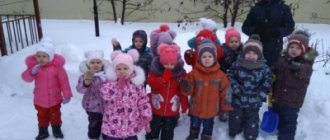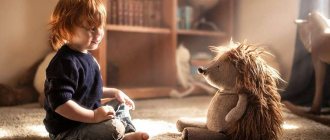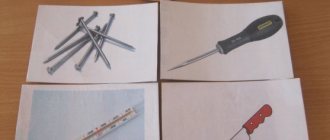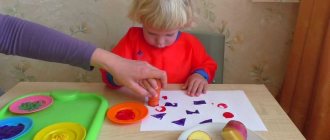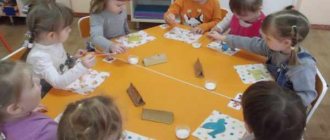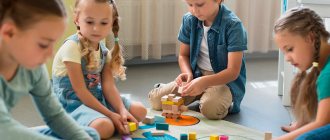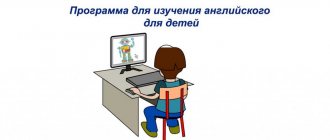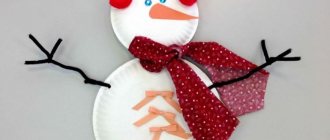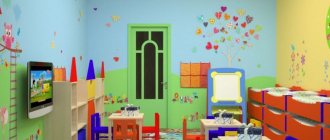What are the features and structure of classes in the senior group?
Activities in kindergarten are given the main place. Education for older preschoolers is carried out mostly in the form of work in subgroups. This includes classes from the cognitive cycle: preparation for mastering literacy, mathematics, familiarization with the outside world, development of musical and rhythmic abilities and artistic and productive activities.
Their peculiarities are both the conduct of the entire lesson in the form of a game, and the inclusion of various game elements in its structure. This makes it easier not only for the child to acquire the necessary knowledge, but also to consolidate it. Through play it is easier to learn how to apply them in practice, since such activities are the main ones for children of this age.
The structure of a lesson in kindergarten in the senior group is determined by its program content. It usually consists of several parts (from one to five). The amount depends on the age of the children and the nature of the tasks assigned to them.
Each part of the lesson is its structural unit and includes various methods and techniques, as well as didactic tools that are aimed at achieving a specific task.
The purpose and objectives of educational activities in the middle group of kindergarten
In the fifth year of a child’s life (middle group of kindergarten), physical and mental processes are rapidly developing. The baby’s actions become more accurate, coordinated, the ability to navigate in space, large and fine motor skills improves. Attention and memory move to a qualitatively new level and become voluntary, that is, the child can remember and reproduce the information that he needs and is interested in. Children master the first logical operations: searching for analogies, comparison, generalization, exclusion. Speech improves and becomes enriched. The child can make simple judgments not only about what he sees at the moment, but also when recalling certain events and imagining them.
Thus, three main tools for understanding the world are improved at once: movement, thinking and speech, which makes a child of this age a tireless explorer of the world around him. It’s not for nothing that the kids in the middle group are called little whys. But, in addition to an increased interest in their surroundings, four-year-olds are characterized by excessive emotionality, high mobility, restlessness, and absent-mindedness. After all, they want to be everywhere and at once, to explore and learn everything.
To direct the energy of fidgets in a useful and safe direction, the teacher of the middle group includes children in interesting and varied activities: outdoor and story games, musical and artistic creativity, familiarization with children's literature, household work, experimentation. These types of activities are carried out at different times of the day, in various forms, using rich visual material, paraphernalia, and folklore.
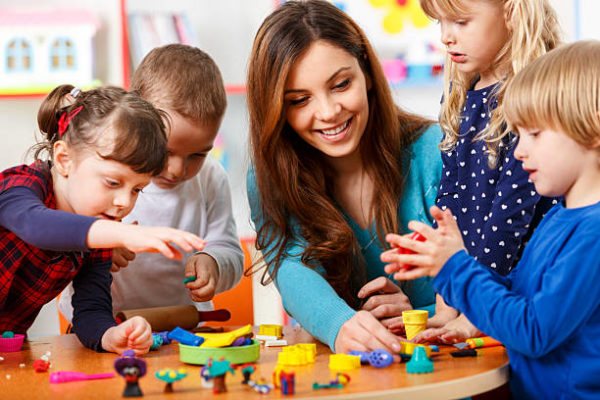
Four-year-old children are energetic and curious, and the teacher needs to direct these qualities to understanding the world around them in various types of activities.
Direct educational activity (DEA) or occupation is of great importance in the development of children. ECD is an activity specially organized by a teacher, aimed at solving certain educational problems.
The main goal of ECD is to streamline and systematize the process of assimilation of information by students, creating conditions for the most complete disclosure of the abilities and skills of each child. The tasks of GCD are varied and usually consist of 1-2 teaching, developmental and educational in accordance with the principle of the trinity of tasks in pedagogy. When planning a lesson, the teacher sets himself one main goal (what needs to be achieved during the lesson) and several ways to achieve it (tasks). Educational tasks are presented to the pupils in a playful way, taking into account the characteristics of their age: not “let’s learn to cut round shapes from a square with scissors”, but “let’s help the squirrel collect delicious apples for the mother squirrel in a basket.”
Examples of children's motivation for educational activities
According to the Federal State Educational Standard, educational activities with preschoolers should be based on the desire and voluntary participation of children. Various methods of motivating children help to fulfill this requirement. Motivation should not be artificial, divorced from previous activities of children, from the general mood that prevails in the group. In order to arouse a natural interest in the upcoming lesson in students, the teacher needs to know well what they are passionate about, what characters and fairy tale heroes they like, and respect their interests.
When offering children a new type of activity, the teacher must be emotional, sincere, and in a good mood, so that his positive attitude towards the lesson is transmitted to the kids. At the same time, you need to know when to stop: excessive display of emotions, a loud unnatural voice can overstimulate sensitive children and reduce interest. You can begin the introductory conversation in a subdued, mysterious tone. This reminds children of the beginning of a fairy tale, attracts their attention, and organizes it.
Table: examples of the motivating beginning of GCD in the middle group
Implementation of an individual approach
An individual or differentiated approach is successfully implemented in classes in all educational areas. So, during educational activities in mathematics or the formation of sound culture of speech, the teacher uses handouts: punched cards, cards with tasks of different levels of complexity, which makes the perception of the material understandable for each child. Those children who are faster than others can take another task card for themselves or help a friend.
In classes in fine arts and design, work in pairs and subgroups (3-4 people each) is used. Children, independently or with the help of a teacher, distribute and complete work in accordance with their own pace and abilities.
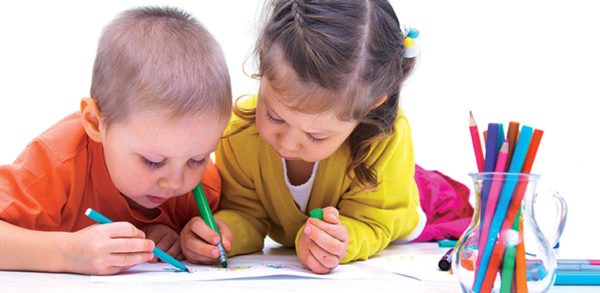
Drawing in pairs develops the ability to negotiate, and also allows children to come to the aid of a friend
Differentiation of tasks can also be carried out during a didactic game. For example, in a math class or learning about nature, you can use a game with a moth, an autumn leaf, or a snowflake. The teacher takes an image of an object and tells the game task: the one on whose shoulder or hand a moth (leaf, snowflake) sits will answer the question. Next, the teacher approaches several children in turn and asks them questions to consolidate what they have learned at different levels of complexity. Only a teacher who knows well the individual characteristics of children, their level of knowledge and abilities can conduct such a game. The game is also useful because it teaches children to listen carefully, not to interrupt, and to help a friend answer correctly.
What knowledge do preschoolers acquire in math classes?
Mathematics classes in the senior group of kindergarten teach children to correctly distinguish between geometric shapes that are similar in shape, for example, a square and a rectangle, as well as analyze objects and describe their shape, evaluate sizes using three indicators: length, width and height.
In older preschoolers, the ability to determine in words how objects are located relative to each other (right, left, in front), to freely navigate in space (standing near a locker, in front of a table, behind a chair), to change the direction of one’s movement (to the right, to the left) and remember the names of the days of the week, as well as their sequence.
Games, joint and independent activities
Games and shared activities are very important for children. They teach children to communicate, develop creative thinking and imagination. During joint classes, a group of children completes tasks proposed by the teacher, thus preschoolers learn to work in a team and develop communication skills.
A total of three hours are allotted for independent games and activities, which allows the child to devote time to his own interests. Children play during the remaining time in such a tight schedule: before morning exercises, before and after classes, during walks.
Use of innovative technologies and techniques
To fill the lesson with original cognitive content, educators are increasingly using pedagogical innovations, successfully applying creative domestic and foreign developments, as well as materials and equipment for them.
Educational games by Voskobovich
The specificity of Vyacheslav Voskobovich’s method is the combination of fascinating fairy tales, in which the child himself becomes a direct participant, and original author’s games. There are about 40 games, and all of them are aimed at the comprehensive development of the child: learning to read and count quickly, sensory perception, improving fine motor skills, design and modeling skills. In addition, they cultivate perseverance and concentration, the ability to complete the work started.
Photo gallery: educational games by V. Voskobovich
Methodology of Nikolai Zaitsev
This technique is aimed at quickly teaching a child to read, and immediately in a continuous manner. The composition (the fusion of a vowel and a consonant, as well as a separate vowel) is not just pronounced, but sung, which is closer to children’s perception, develops fluency of speech and speech breathing.
Of the manuals in the technique, the most widely used is a set of cubes on which letters are drawn indicating sounds and warehouses, as well as tables of warehouses. Each cube is painted in a specific color and has a filling (rustling or ringing), thanks to which children easily learn the concepts of “hard and soft”, “voiceless and voiced consonant”.
Principles of Zaitsev’s technique:
- From general to specific and from specific to general.
- From the concrete-figurative through the visual-effective to the verbal-logical.
- Providing visibility using various channels of perception. Systemic material supply.
- Algorithmization of educational actions.
- Taking into account the physiology of perception of educational information.
- Protecting the health of students.
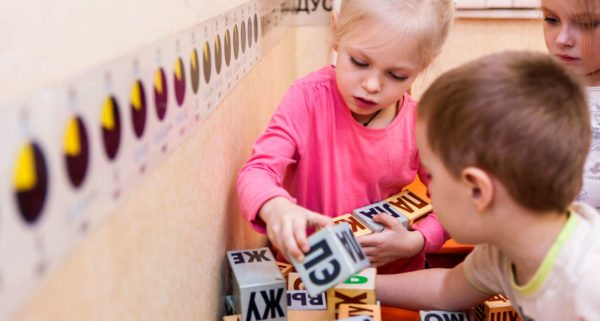
Zaitsev's cubes have sounding fillings, so children can not only see them, but also hear them
Dienesh blocks and Cuisenaire sticks
Activities using such aids as Dienesh blocks and Cuisenaire sticks are gaining enormous popularity in kindergarten. The former teach children the formation and division of sets into subsets based on the characteristics of elements (shape, color, thickness), the construction of logical chains, elimination operations, and analogy.
Sets of bright blocks, multi-colored geometric bodies, are initially perceived by children as a convenient building material, but over time, children learn to think logically, finding relationships between the characteristics of objects (blocks) and their sets.
Brightly colored Cuisenaire sticks are also attractive to children. While playing with them, children gradually learn to count within 10, compare numbers, find adjacent ones, and become familiar with the concept of number composition and even multiplicity.
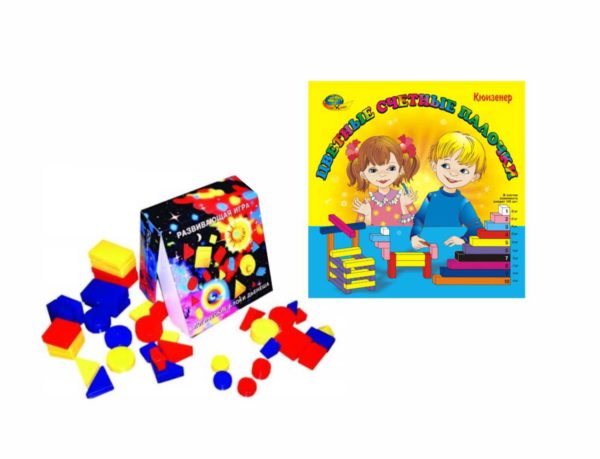
Dienesh blocks and Cuisenaire sticks are gaining more and more popularity in kindergartens and are very popular with children
Video: master class on educational games in preschool educational institutions
Information and communication technologies (ICT)
Informatization of the developing educational environment of preschool educational institutions is a requirement of the time. Modern technologies surround the child at home and in public places, therefore, the kindergarten cannot remain aloof from them, because its task is to prepare children for life as best and fully as possible.
ICT is used in classes in two forms: multimedia presentations or slide shows with an interactive whiteboard; educational games, programs using a computer (laptop). An interactive whiteboard allows you to create a unique environment in the classroom. It will help the teacher create a picture of the forest, sea, and space that is close to real. Bright, moving, large images created for presentations will help children quickly and clearly understand what is being discussed in the lesson. Educational computer games and programs develop children's speed and flexibility of thinking and increase interest in educational activities. However, we should not forget that ICTs are auxiliary means of learning; they cannot replace live communication, conversation, or ordinary didactic games; everything must be combined in moderation.
There are several rules for maintaining the health of children in classes using ICT:
- Children in the middle group can “communicate” with a computer no more than 5–7 minutes a day, 2–3 times a week.
- The distance from children to the multimedia board is at least 2–2.5 m.
- Mandatory games and exercises to relieve visual strain (eye gymnastics).
Types and forms of direct educational activities in the middle group of preschool educational institutions
It is very important to choose the optimal form and type of lesson. After all, modern views on preschool pedagogy give the teacher a lot of scope for creativity, but at the same time require the manifestation of creativity, an innovative approach and out-of-the-box thinking. How do new GCDs differ from usual activities?
In accordance with the requirements of the Federal State Educational Standard, direct educational activities should be built on the basis of partnership and mutual respect of all participants in the educational process, while the old lesson model copied the school lesson and assumed an authoritarian, commanding position of the teacher and a dependent, passive position of the children.
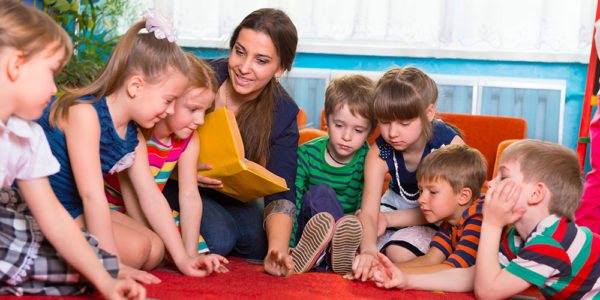
The modern approach to preschool pedagogy assumes equality between children and adults in the educational process
Despite the fact that “classes-lessons” in kindergarten are a thing of the past, the term “classes” itself is used by teachers as a synonym for educational activities, but has acquired new content.
Table: difference between GCD and classical classes
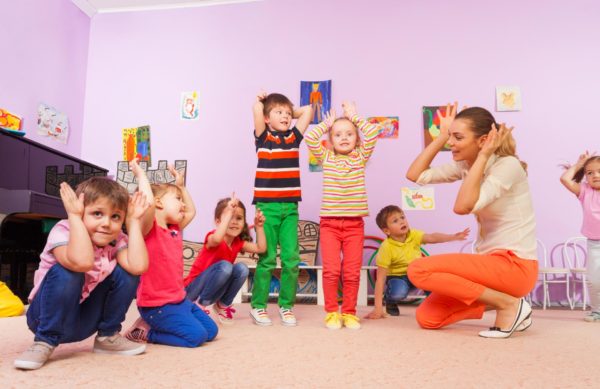
In modern classes there is a place for both fun and active play.
Of course, a teacher will be able to conduct a full-fledged lesson in accordance with the new requirements only after being properly prepared to ensure high dynamism and a change in types of activity. The number of children is also important. In some cases, a group of students is divided into subgroups of 10–12 people. In addition, you need to think about the type of activity. According to the main didactic task, this could be:
- Learning new material.
- Consolidating what was previously learned.
- Creative reproduction of knowledge, skills (mini-concert, quiz, reading competition, dramatization of a small work of art, fairy tales).
- Combined (two learning tasks are solved).
According to the type of knowledge delivery, GCDs are:
- Classic or single theme. Their structure is the simplest: organization of the lesson, presentation of new information, reinforcement in 1-2 didactic games, conclusion.
- Complex. They sequentially alternate activities from different educational areas, for example, after reading a story about animals, there is a low-mobility game “Let's imagine ourselves as animals,” then children draw a hero of the work or make a treat for the animals.
- Integrated. Elements of different educational areas in such a lesson are intertwined so closely that they cannot be separated. Let’s imagine that a good Dwarf came to the lesson “Golden Autumn Brings Gifts.” First, he plays with the children the game “Say the opposite” based on the phenomena of autumn (speech + cognitive development), then the outdoor game “Place vegetables and fruits in baskets (physical + cognitive development), and as a keepsake for the Gnome, the children draw smiling clouds and the sun (artistic development). aesthetic + socio-communicative development).
To diversify educational activities, teachers use such unusual forms of organizing classes as plot-games, quests, travel, searching for objects, and theatrical performances. Training sessions in which children master social skills (“Learning to be friends”, “We are on duty”, “Taking care of indoor plants”) are becoming increasingly popular.
Whatever the form of the lesson, it should be remembered that its duration, according to sanitary standards, should not exceed 20 minutes, and for integrated, complex and non-traditional ECD with high mobility - 25–27 minutes.
Table: structure and duration of educational activities in the middle group of preschool educational institutions
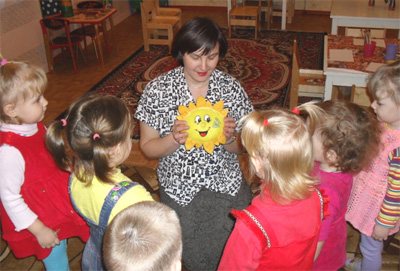
The game character, who came to the kids at the beginning of the lesson, in the final part of it can ask what interesting things the children learned and saw
